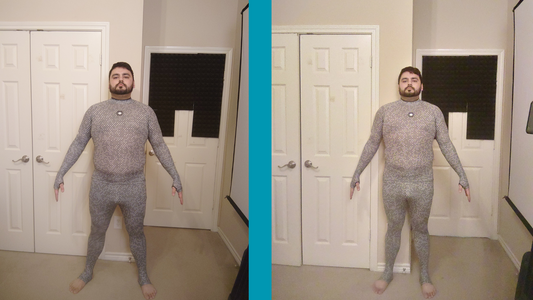

Finding the Right Macros Percentage for Weight Loss
A diet built around macronutrient percentages can help you lose weight as long as you maintain a calorie deficit. You'll need to set a calorie target that is less than your total daily energy expenditure (TDEE) and adjust each macros percentage for weight loss. Let ZOZOFIT show you how to calculate your TDEE and macro percentages for weight loss based on your goals.
How To Calculate a Macros Percentage for Weight Loss
Determining your TDEE is the first step toward calculating macros. This begins with knowing your basal metabolic rate and factoring in the calories you burn during daily activities and exercise.
The Mifflin-St. Jeor equation can help you calculate your BMR and TDEE. This equation varies slightly for men and women, so you may prefer to use a calculator tool. Subtract 300 to 500 calories from your TDEE to set a calorie deficit target for weight loss. Once you have a calorie target, you are ready to calculate your macros percentage for weight loss.
To lose fat, the current recommended ratio is 50% carbohydrates, 35% protein and 15% fat. Nutritionists previously recommended a ratio of 30% carbohydrates, 45% protein and 25% fat, but recent studies report better results from an adjusted ratio with more carbohydrates to fuel exercise and slightly less protein and fat.
The Difference Between Losing Fat and Losing Weight
Many people focus on weight loss rather than specifically losing fat, but it's important to understand the difference between these goals. Weight loss includes loss of muscle tissue and water as well as fat and will continue as long as you run a calorie deficit. If you want to lose fat but retain muscle, you'll need a different calorie target and macro ratio.
Fat loss reduces energy stored in the body. A macros percentage for weight loss that preserves muscle may have higher fat and protein targets. You should also consider adjusting your percentages based on your body type and the amount of exercise you do per day.
Most people who want to lose weight are mesomorphs or endomorphs. Mesomorphs are naturally inclined to build muscle. A 40% carbohydrate, 30% protein and 30% fat ratio may be the best macro percentages for these individuals.
Endomorphs may be more likely to store fat and have a slower BMR and lower tolerance for carbohydrates. People with this body type may see more fat loss from a 25% carbohydrate, 35% protein and 40% fat ratio, though a lower fat macro target could be desirable for general weight loss.
Calorie Deficiency vs Macro Percentages for Weight Loss
In general, running a daily calorie deficiency between 300 calories and 500 calories will promote weight loss. You should also factor in your level of activity. A ratio of 50% carbs, 35% protein, 15% fat ratio can be suitable for weight and fat loss with light to moderate exercise.
If you do more intense exercise, you may need a higher percentage of fat, such as 25% to 30%, for concentrated energy and a slightly lower ratio of carbs in the range of 40% to 45%. A 30% to 35% range for protein can support muscle development while still promoting weight loss.
In addition to your BMR and TDEE with calorie deficit, your goals and lifestyle should also factor into your macros percentage for weight loss. You can track your progress towards any nutrition and fitness goals by taking full body scans with ZOZOFIT.
How To Make a Macro Meal Plan For Weight Loss
As long as your calorie and macro targets fall within the general recommended range and you burn more calories than you consume, you should lose weight. Here are the acceptable macronutrient distribution ranges set by the Institute of Medicine of the National Academies:
- Carbohydrates account for 45% to 65% of total calories.
- Protein accounts for 10% to 35% of total calories.
- Fat accounts for 20% to 35% of total calories.
The latest recommended macro percentages for fat loss of 50% carbs, 35% protein and 15% fat fall within the recommended ranges for carbohydrates and at the upper end of the recommended range for protein. This ratio has a lower percentage of calories from fat than the general recommendation to prioritize burning stored energy.
If you want to maintain or build muscle mass, you may need more fat to fuel exercise and slightly less carbohydrates. Your protein ratio should stay around 30% to 35%. You can also experiment with a slightly adjusted macros percentage for weight loss, such as the 40-30-40 formula, in which 40% of calories come from carbohydrates, 30% of calories come from protein and 30% of calories come from fat.

Continuing to monitor changes to your body and determining the perfect macros percentage will help you achieve your weight loss goals.
Why Adjust Calorie and Macro Targets Over Time
A phenomenon called metabolic adaptation could be one reason why you might need to adjust your calorie and macro percentages as you lose weight. A recent study found that metabolic adaptation after a 16% weight reduction slowed the rate of ongoing weight loss for some participants.
Once you reach your goal weight, you will need to adjust your targets to maintain your weight. An energy balance involves consuming the same amount of calories as your TDEE. Some individuals may find it helpful to set a lower carbohydrate target. A Harvard study found that body composition and levels of insulin and other hormones determine the effects of carbohydrate consumption on fat storage.
Some individuals are prone to leptin resistance, which means that their brains do not receive signals from their body to suppress appetite once full. A lower ratio of carbs to protein and fat can be helpful for people who have this condition. You might also adjust your targets to accommodate changing fitness goals, such as building muscle.
Finding the Right Macros Percentage for Weight Loss
The right macros percentage for weight loss depends on your goals. A calorie deficit is the most important factor for losing weight, while macro percentages for weight loss are more relevant for losing fat while keeping or gaining muscle. Download the ZOZOFIT app on your phone to take 3D body scans and track your progress towards any fitness goals.

![zf-w-[168px] zf-h-[40px]](http://zozofit.com/cdn/shop/t/15/assets/logo-desktop.png?v=117713855448369080381753069598)




